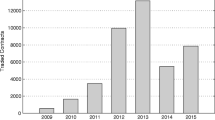Abstract
This paper presents an alternative approach for interest rate lattice construction in the Ritchken and Sankarasubramanian (1995) framework. The proposed method applies a parsimonious induction technique to represent the distribution of auxiliary state variables and value interest rate derivatives. In contrast to other approaches, this technique requires no numerical interpolations, approximations and iterative procedures for pricing interest rate options using a simple backward induction and, therefore, provides significant computational advantages and flexibility with respect to existing implementations. Also, the proposed trinomial interest rate lattice specification provides for a further reduction in computational costs with additional flexibility. The results of this work can be extended to a class of derivatives pricing models with path dependent state variables and generalized to multi-factor models.
Similar content being viewed by others
References
Andersen, L., “A Simple Approach to the Pricing of Bermudan Swaptions in Multi-Factor Libor Market Model.” Working Paper, General Re Financial Products, 1999.
Barraquand, J. and D. Martineau, “Numerical Valuation of High Dimensional Multivariate American Securities.” Journal of Financial and Quantitative Analysis 30 (1995).
Broadie, M. and P. Glasserman, “Pricing American.Style Securities Using, Simulation.” Journal of Economic Dynamics and Control 21(8–9), 1323–1352 (1997a).
Broadie, M. and P. Glasserman, “A Stochastic Mesh Method for Pricing High. Dimensional American Options.” Columbia University Working Paper, 1997b.
Carr P. and G. Yang, “Simulating American Bond Options in an HJM Framework.” Quantitative Analysis in Financial Markets 2 (1998) (forthcoming).
Clewlow, L. and C. Strickland, “Pricing Interest Rate Exotics in Multi-Factor Gaussian Interest Rate Models.” Working Paper at http://ssrn.com/abstract= 128669.
Das, S. and A. Sinclair, “Monte Carlo Markov Chain Methods for Derivative Pricing.” Santa Clara University Working Paper, 2001.
Grant, D., G. Vora, and D. Weeks, “Path. Dependent Options: Extending the Monte Carlo Simulation Approach.” The University of New Mexico Working Paper, 1994.
Heath, D., R., Jarrow, and A. Morton, “Bond Pricing and the Term Structure of Interest Rates: A New Methodology for Contingent Claims Valuation.” Econometrica 70, 77–105 (1992).
Hull, J. and A. White, “Pricing Interest Rate Derivatives Securities.” Review of Financial Studies 3, 573–592 (1990).
Hull, J. and A. White, “Numerical Procedures for Implementing Term Structure Models I: Single Factor Models.” Journal of Derivatives 2, 7–16 (1994).
Li, A., P., Ritchken, and L. Sankarasubramanian, “Lattice Models for Pricing American Interest Rate Claims.” Journal of Finance 50, 719–737 (1995).
Lin, J. and P. Ritchken, “On Pricing Derivatives in the Presence of Auxiliary State Variables.” Working Paper, 2001.
Longstaff, F. and E. Schwartz, “Valuing American Options by Simulation: A Simple Least-Squares Approach.” Review of Financial Studies 14, 113–147 (2001).
Nelson, D.B. and K. Ramaswamy, “Simple Binomial Processes as Diffusion Approximations in Financial Models.” Review of Financial Studies 3, 393–430 (1990).
Ritchken, P. and I. Chuang, “Interest Rate Option Pricing with Volatility Humps.” Review of Derivatives Research, 3, 237–262 (1999).
Ritchken, P. and L. Sankarasubramanian, “Volatility Structures of Forward Rates and the Dynamics of the Term Structure.” Mathematical Finance 5, 55–72 (1995).
Sinclair, A. and M. Jerrum, “Approximate Counting, Uniform Generation and Rapidly Mixing Markov Chains.” Information and Computation 82, 93–133 (1989).
Tilley, J. A., “Valuing American Options in a Path Simulation Model.” Transactions of the Society of Actuaries 45, 83–104 (1993).
Author information
Authors and Affiliations
Corresponding author
Rights and permissions
About this article
Cite this article
Kramin, M.V., Kramin, T.V., Young, S.D. et al. A Simple Induction Approach and an Efficient Trinomial Lattice for Multi-State Variable Interest Rate Derivatives Models. Rev Quant Finan Acc 24, 199–226 (2005). https://doi.org/10.1007/s11156-005-6337-y
Issue Date:
DOI: https://doi.org/10.1007/s11156-005-6337-y



